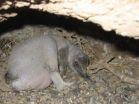(Press-News.org) ST. LOUIS – Saint Louis University researchers have identified a novel mechanism to control the traffic of cells and fluid from tissues to lymphatic vessels. It may be possible to harness this mechanism to fight cancer spread from one organ to another organ and improve the effectiveness of vaccines.
The lymphatic system is an extensive fluid transit system, consisting of vessels in the body. It defends the body against infection. Cancer cells and infection-fighting cells that are part of the immune system use the lymphatic system to get to other organs, including the lymph nodes.
When cancer cells travel along the lymphatic system from one part of the body to another, they can cause metastases – spread to other organs. Many cancer cells, such as those from breast cancer, prostate cancer and lung cancer, enter the lymphatic vessels by releasing molecules that unbutton button-like structures between lymphatic lining cells. This enables them to gain passage into or out of the lymphatic transport system.
SLU scientists have found that molecules known as CRSBP-1 (also termed LYVE-1) ligands, which are a group of growth factors and cytokines, bind to CRSBP-1 receptors, which are located on the surface of lymphatic vessels. This stimulates a response, and acts like a token to gain entry to the lymphatic vessel network. This mechanism for getting into the lymphatic system is used by many cancer cells.
"When the token binds to CRSBP-1, it opens the gate," said Wei-Hsien Hou, Ph.D., lead author of the paper and an M.D./Ph.D. student at Saint Louis University School of Medicine. "Our study is the first to identify a function for this protein. It's important because it gives us a new target to block metastasis, treat edema (swelling of the body from fluid build-up) and enhance the effectiveness of vaccines by strengthening the body's immune responses."
The research team also found that that CRSBP-1 ligand molecules (PDGF-BB and VEGF-A) decrease edema in a mouse model by opening lymphatic intercellular junctions, allowing fluid to drain through the lymphatic network and causing swelling to go down.
Understanding how to gain access into the lymphatic network is significant and will have a strong impact in the fields of cancer and immune research, said Jung S. Huang, Ph.D., a study co-author, professor of biochemistry and molecular biology at Saint Louis University and Hou's mentor. "Once you figure out how breast and other cancers spread, you can begin to work on blocking the process. This is very exciting," he said.
INFORMATION:
The research, which was supported by grants from the National Institutes of Health, was reported in the April 15 issue of the Journal of Cell Science. Other co-authors in this paper include I-Hua Liu, M.S, Cheng C. Tsai, M.D., Frank E. Johnson, M.D. and Shuan S. Huang, Ph.D.
Established in 1836, Saint Louis University School of Medicine has the distinction of awarding the first medical degree west of the Mississippi River. The school educates physicians and biomedical scientists, conducts medical research, and provides health care on a local, national and international level. Research at the school seeks new cures and treatments in five key areas: cancer, infectious disease, liver disease, aging and brain disease and heart/lung disease.
END
TORONTO, On – April 8, 2011 – Increased levels of a protein that helps regulate the body's blood pressure may also predict a major cardiovascular event in high-risk patients, according to a study led by St. Michael's Hospital's cardiovascular surgeon Subodh Verma. Measuring the amount of the protein, known as plasma renin activity (PRA), in the blood stream may give doctors another tool to assess a patient's risk and help prevent a heart attack or stroke.
"Conventional factors like genetics and environment do not always provide a complete patient story and an understanding ...
A galaxy's core is a busy place, crowded with stars swarming around an enormous black hole. When galaxies collide, it gets even messier as the two black holes spiral toward each other, merging to make an even bigger gravitational monster.
Once it is created, the monster goes on a rampage. The merger kicks the black hole into surrounding stars. There it finds a hearty meal, shredding and swallowing stars at a rapid clip. According to new research by Nick Stone and Avi Loeb (Harvard-Smithsonian Center for Astrophysics), upcoming sky surveys might offer astronomers a way ...
EUGENE, Ore. -- Each October, the color pink marks the arrival of National Breast Cancer Awareness Month. Media coverage, product promotions and even the football gridirons showcase the national effort to promote screenings and early detection of the cancer that 200,000 American women are diagnosed with each year.
New research from the University of Oregon examined more than 30 years of cancer registry data to determine if October events related to National Breast Cancer Awareness Months (NBCAM) lead to increases in breast cancer diagnoses in the following month of November. ...
CORVALLIS, Ore. – One of the first studies of its type has confirmed that a science museum can strongly influence the public's knowledge and attitudes about science and technology, and to a surprising degree can cut across racial, ethnic, educational and economic barriers.
The study focused on the California Science Center in Los Angeles, and offers profound support for the value of such institutions. It also reinforces the emerging concept of "free choice" learning, which holds that people get most of their knowledge about science from someplace other than school or ...
Neurosurgeons from NYU Langone Medical Center will present techniques and discuss surgical approaches and applications of technology at the annual meeting of the American Association of Neurological Surgeons (AANS), held April 9-13, 2011 at the Colorado Convention Center in Denver.
The Department of Neurosurgery at NYU Langone Medical Center has been recognized as one of the top ten hospitals in the country for neurology and neurosurgery by U.S. News & World Report for the past three years. This year, the department expanded its expertise with the addition of several ...
Researchers from the Wildlife Conservation Society, the University of Washington, and other groups are grappling with a wildlife mystery: Why are some penguin chicks losing their feathers?
The appearance of "naked" penguins—afflicted with what is known as feather-loss disorder—in penguin colonies on both sides of the South Atlantic in recent years has scientists puzzled as to what could be causing the condition.
A study on the disorder appears in a recent edition of the journal Waterbirds. The authors of the paper are: Olivia J. Kane, Jeffrey R. Smith, and P. Dee ...
OAK RIDGE, Tenn, April 8, 2011 -- A newly sequenced bacterial genome from a team led by the Department of Energy's Oak Ridge National Laboratory could contain clues as to how microorganisms produce a highly toxic form of mercury.
Methylmercury, a potent human neurotoxin, appears in the environment when certain naturally occurring bacteria transform inorganic mercury into its more toxic cousin. Few bacterial species are capable of this conversion, and exactly how the transformation takes place has been a matter of debate for decades.
"What is not known are the genes ...
The hand moves the computer mouse, but the cursor doesn't comply. The cursor doesn't go where told.
The hand tries again. The cursor shoots past the intended target.
The hand tries a third time – and the cursor loops farther from the target than where it started. And the user is frustrated.
So it often goes for computer users whose motor disabilities prevent them from easily using a mouse.
As the population ages, more people are having trouble with motor control, but a University of Washington team has invented two mouse cursors that make clicking targets a whole ...
WASHINGTON, D.C. – It is important that the United States begin to live within its means and address the federal deficit. But APS believes that as a nation we need to be smart about how we do it. Cutting spending across the board without a clear understanding of what it means for America's future jeopardizes the very future we want to secure for our children.
For more than half a century, science and technology have been the primary drivers of job creation and economic growth. Slashing spending on science, as the budget plans of the House of Representatives call for, ...
The phrase "invasive plant species" typically evokes negative images such as broad swaths of kudzu smothered trees along the highway or purple loosestrife taking over wetlands and clogging waterways—and as such, invasive plants are largely viewed as major threats to native biodiversity. However, research has shown both that invasive species may be one of the most important threats to biodiversity and that plant invasions are rarely the cause for native species extinctions. How can these conflicting pieces of evidence be reconciled?
Kristin Powell, from Washington University, ...




